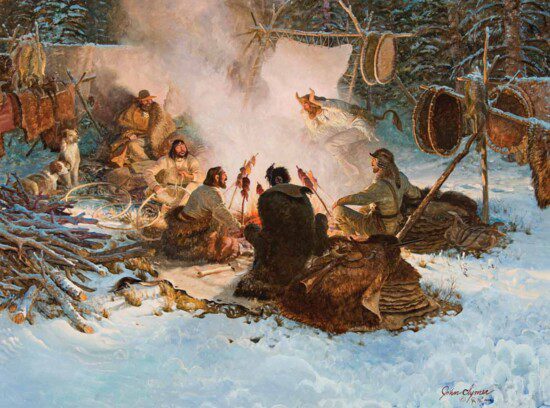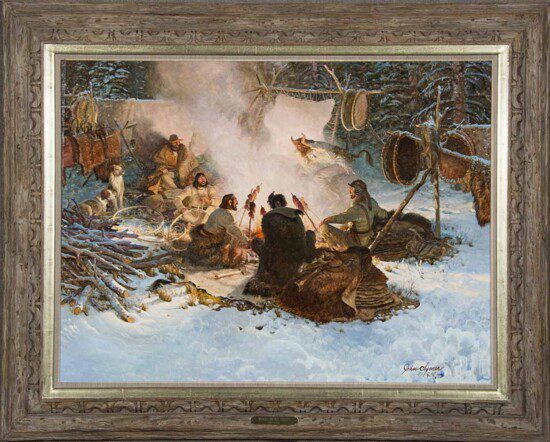Additional Information
Literature:
The West of John Clymer, Walt Reed, National Cowboy Hall of Fame & Western Heritage Center, Oklahoma City, OK, 1991: p. 21.
With a John Clymer painting, it’s all in the details. His works are meant to be explored with the eye. A piece like Wood Smoke Tales is a perfect example of this phenomenon. It rewards those who poke around the composition, admiring the tiny pieces of history that the artist hides within the fully realized story. And there are many details in Wood Smoke Tales: the smiling figure making willow hoops for beaver pelts, the skewers with chunks of meat smoking over a roaring fire, the serious expression on two dogs huddled at the edge of the painting, a light dusting of snow on a pile of firewood, and the way the figure furthest from the fire is bundled against the cold while those closest to the flames have shed their blankets.
The painting is a companion piece to one of Clymer’s most famous works, Alouette, which shows a similar campfire scene with trappers dancing jovially around a meticulously designed fur camp. Both paintings seem to show the same figures: grizzled hunters enjoying a break from their adventures in the wilderness. Some of the smiles look familiar but so does a dog, knife sheaths, powder horns and even a wood-handled hatchet that has a prominent place in both paintings. It’s not a stretch to imagine the two paintings show the same camp several months apart.
Both Alouette, from 1974, and Wood Smoke Tales, from 1976, were featured in The West of John Clymer, the 1991 exhibition that opened at what was then the National Cowboy Hall of Fame in Oklahoma City. The catalog for the exhibition praises the artist, but also lays significant credit at the feet of John’s wife, Doris, who helped her husband research the history he was painting. He often credited her for some of the finer details that ended up in his paintings. “During the summers, the Clymers enthusiastically explored the country, looking particularly for the haunts of mountain men, hunters, trappers and migrating settlers. Among their explorations were the Bozeman Trail, the route of Lewis and Clark from Missouri to the Pacific, the old Chisholm Trail from Texas to Abilene, Kansas, and the route of the Nez Perce flight toward Canada. Each of these trips resulted in paintings, visualizing events written or told, but not pictured before. Clymer’s paintings and drawings, therefore, are in the tradition of Karl Bodmer, Alfred Jacob Miller and George Caleb Bingham, artists who also recorded the events of the frontier…” writes Walt Reed in the 1991 exhibition’s catalog. “John’s own life was ideal preparation for the visualization and authentic recreation of the Old West. To the end, he devoted himself diligently to fill in the missing paragraphs in the chapters of history that we can now read with more clarity and understanding of our forebears in these paintings he created in the Teton Village studio.”


